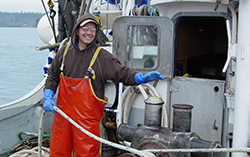Commercial fishing
Commercial fishing is the activity of catching fish and other seafood for commercial profit, mostly from wild fisheries. It provides a large quantity of food to many countries around the globe, but those who practice it as an industry must often pursue fish far into the ocean under adverse conditions. Commercial fishing methods have become very efficient using large nets and sea-going processing factories. Individual fishing quotas and international treaties seek to control the species and quantities caught.
History[edit | edit source]
The history of commercial fishing is ancient, dating back to at least the beginning of the Neolithic period about 10,000 years ago. Archaeological evidence shows that humans were capturing fish in nets and on hooks, and later, boats enabled the fishery to reach offshore grounds. The Ancient Egyptians, Phoenicians, and Vikings were among the early cultures involved in commercial fishing, utilizing the abundant resources of the Mediterranean Sea, Atlantic Ocean, and North Sea, respectively.
Methods[edit | edit source]
Commercial fishing uses various methods to capture fish at a large scale. Some of the most common methods include:
- Trawling: Dragging a fishing net along the sea bottom or in midwater at a specified depth.
- Purse seining: Encircling a school of fish with a long net and then closing its bottom.
- Longlining: Using long lines with baited hooks, spread out over miles of ocean.
- Gillnetting: Using nets that catch fish by their gills in vertical panels.
Each method has its specific target species and environmental impact, with concerns over bycatch (the capture of unintended species) and habitat destruction being prominent.
Sustainability and Regulation[edit | edit source]
The sustainability of commercial fishing is a significant concern. Overfishing, where fish stocks are depleted faster than they can recover, threatens many fish populations and the ecological balance of the oceans. To combat these issues, various international agreements and regulations, such as the United Nations Convention on the Law of the Sea (UNCLOS) and the policies of the Food and Agriculture Organization (FAO), have been implemented. These measures include setting quotas, establishing marine protected areas, and enforcing sustainable fishing practices.
Economic Impact[edit | edit source]
Commercial fishing is a major economic activity that supports millions of jobs worldwide, not only for those directly employed in fishing but also in related industries such as processing, equipment manufacturing, and retail. Major fishing nations like China, the United States, Japan, and Russia play significant roles in the global seafood market. However, the industry also faces challenges such as fluctuating fish stocks, changing market demands, and the impact of climate change on ocean ecosystems.
Environmental Impact[edit | edit source]
The environmental impact of commercial fishing includes habitat destruction, such as damage to seabed from trawling, and the aforementioned bycatch, which can significantly affect marine biodiversity. Efforts to reduce these impacts include gear modifications, closed seasons, and protected areas.
Future Challenges[edit | edit source]
The future of commercial fishing depends on balancing the industry's economic benefits with the need to preserve marine ecosystems for future generations. Innovations in fishing technology and management practices, along with increased international cooperation, are crucial for achieving sustainable fisheries.
Search WikiMD
Ad.Tired of being Overweight? Try W8MD's NYC physician weight loss.
Semaglutide (Ozempic / Wegovy and Tirzepatide (Mounjaro / Zepbound) available. Call 718 946 5500.
Advertise on WikiMD
|
WikiMD's Wellness Encyclopedia |
| Let Food Be Thy Medicine Medicine Thy Food - Hippocrates |
Translate this page: - East Asian
中文,
日本,
한국어,
South Asian
हिन्दी,
தமிழ்,
తెలుగు,
Urdu,
ಕನ್ನಡ,
Southeast Asian
Indonesian,
Vietnamese,
Thai,
မြန်မာဘာသာ,
বাংলা
European
español,
Deutsch,
français,
Greek,
português do Brasil,
polski,
română,
русский,
Nederlands,
norsk,
svenska,
suomi,
Italian
Middle Eastern & African
عربى,
Turkish,
Persian,
Hebrew,
Afrikaans,
isiZulu,
Kiswahili,
Other
Bulgarian,
Hungarian,
Czech,
Swedish,
മലയാളം,
मराठी,
ਪੰਜਾਬੀ,
ગુજરાતી,
Portuguese,
Ukrainian
Medical Disclaimer: WikiMD is not a substitute for professional medical advice. The information on WikiMD is provided as an information resource only, may be incorrect, outdated or misleading, and is not to be used or relied on for any diagnostic or treatment purposes. Please consult your health care provider before making any healthcare decisions or for guidance about a specific medical condition. WikiMD expressly disclaims responsibility, and shall have no liability, for any damages, loss, injury, or liability whatsoever suffered as a result of your reliance on the information contained in this site. By visiting this site you agree to the foregoing terms and conditions, which may from time to time be changed or supplemented by WikiMD. If you do not agree to the foregoing terms and conditions, you should not enter or use this site. See full disclaimer.
Credits:Most images are courtesy of Wikimedia commons, and templates, categories Wikipedia, licensed under CC BY SA or similar.
Contributors: Prab R. Tumpati, MD




